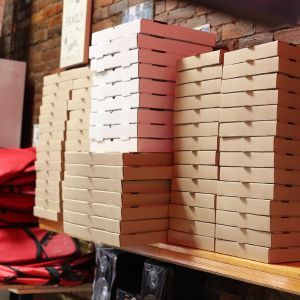Choosing the Right Pizza Box: Why Cardboard Thickness Matters
For commercial food businesses across New Zealand, the quality of your pizza packaging directly affects food safety, presentation, and customer satisfaction. While box size is often the first consideration, cardboard thickness is just as critical—particularly when it comes to heat retention, grease resistance, and product integrity during delivery.
Whether you're running a pizzeria, food truck, catering company, or takeaway outlet, choosing the right pizza box thickness can reduce product damage, protect your brand image, and support hygiene compliance. In this article, we explain why cardboard thickness matters, what options exist, and how to choose the best type for your commercial needs.
Looking for guidance on pizza box size? Read our full guide here:
Why Cardboard Thickness is Crucial in Pizza Packaging
1. Structural Strength & Stackability
Thicker cardboard improves the box’s ability to carry heavier pizzas—especially with thick crusts, loaded toppings, or extra-large sizes. It also prevents the box from sagging or collapsing under weight, whether stacked in-store or during delivery.
This is essential in high-volume environments like:
-
Corporate catering
-
Bulk takeaway orders
-
Event catering with multiple stacked pizzas
2. Heat Retention & Temperature Control
Cardboard thickness plays a key role in insulation. A thicker pizza box helps retain heat, keeping pizzas warmer for longer. This is particularly important for delivery operations or extended holding times before consumption.
Tip: A snug box fit paired with a medium- to high-flute cardboard type (like B-flute) provides the best balance between insulation and stackability.
3. Grease Resistance & Hygiene
Thicker cardboard often includes a stronger internal liner that better resists grease penetration. This keeps the exterior clean and prevents weakening of the structure due to oil absorption.
Food safety note: Boxes should always be manufactured from food-grade materials that meet NZ hygiene standards. Look for certified, BPA-free, and sustainable cardboard sources.
Common Types of Cardboard Used in Pizza Boxes
Cardboard Type |
Description |
Best For |
|
E-Flute |
Thin, fine fluting (≈1.2 mm). Good for printing and smaller pizzas. |
Personal/slice boxes, branding-heavy designs |
|
B-Flute |
Medium fluting (≈2.5–3 mm). Stronger and better insulation. |
Most standard commercial pizza boxes |
|
C-Flute |
Thicker fluting (≈3.5–4 mm). Maximum protection and insulation. |
XL pizzas, deep dish, catering transport |
|
Double Wall (e.g. EB or BC) |
Two layers of fluting for extra durability. |
Heavy pizzas, long-distance delivery, stack-heavy operations |
Choosing the Right Thickness Based on Pizza Type
Pizza Type |
Recommended Thickness |
Rationale |
|
Thin crust, small |
E-Flute (1.2 mm) |
Lightweight, cost-effective, easy to brand |
|
Medium/standard |
B-Flute (2.5–3 mm) |
Balance of strength and insulation |
|
Deep dish or loaded |
C-Flute (3.5+ mm) |
Supports weight, resists grease, maintains shape |
|
Catering/multi-stack |
Double Wall |
Prevents crushing, ensures safe stacking |
Additional Considerations for Commercial Buyers
-
Storage space: Thicker boxes may take up more storage—ensure your site can accommodate them.
-
Printing needs: Thinner flutes (like E) are more print-friendly. If branding is a priority, balance thickness with surface finish quality. For more guidance on this, read our article: [Plain vs Printed Pizza Boxes: Which is Better for Your Food Business? – Coming Soon].
-
Sustainability: Look for FSC-certified, compostable, or recyclable cardboard options where possible. Some thicker boxes may include recycled content but should still meet hygiene standards.
FAQ – Cardboard Thickness in Pizza Boxes
Does a thicker box always mean better quality?
Not necessarily. You should match the box thickness to the pizza type, weight, and delivery method. Over-specifying increases cost unnecessarily.
What flute size retains heat best?
C-Flute or B-Flute boxes offer good heat retention due to their depth and air insulation properties.
Can I print on thicker boxes?
Yes, but print quality is usually sharper on thinner boards like E-Flute. For thicker flutes, simplified branding works best.
Are thicker pizza boxes more sustainable?
Not always. Sustainability depends on the source and recyclability of the material, not just thickness. Look for certifications like FSC or compostable logos.
Final Thoughts
Cardboard thickness plays a pivotal role in protecting your product, preserving heat, and enhancing the customer experience. By matching the box structure to your pizza style, service model, and delivery requirements, you ensure consistent quality and brand reputation.
At Insinc Products, we offer a range of pizza boxes in various thicknesses, sizes, and sustainable options—ideal for commercial kitchens, food trucks, caterers, and pizzerias across New Zealand.
Need help choosing the right pizza box thickness? Contact us for product advice, samples, or to discuss bulk supply options.
Posted: Friday 12 September 2025


